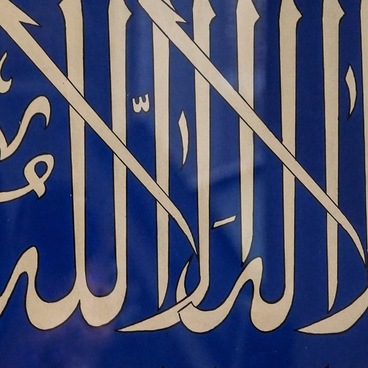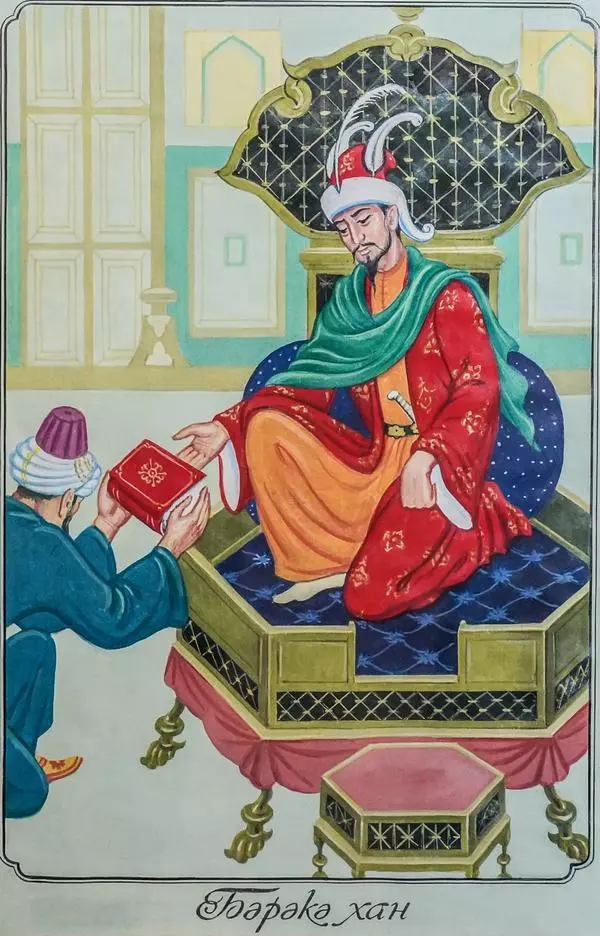Rushan Shamsutdinov, a drawing artist and a calligraphist, dedicated his painting to a very important holiday of Moslem calendar — Kurban Bayram (Greater Eid or Feast of Sacrifice). In the centre of the composition he depicted a complex of the sacred Mosque with Kaaba, the cube-shaped temple, situated in Mecca — the Holy City for all the Moslems in Saudi Arabia. Prophet Mohammed was born there, and he turned Kaaba into the main worship place in Islam. Since then, the Moslems visit it as part of their ritual pilgrimage – Hajj and Umrah.
According to the legend, it was Adam, the first human male, who built this shrine, but during the Great Flood, it was destroyed. Later, at the behest of Allah it was restored. Prophet Ibrahim (Abraham) with his wife Hagar and son Ismail came to Mecca. Here they found the place, where Kaaba used to stand. The construction went on with the assistance of angel Jabrail. Ibrahim laid the walls rising on the stone, which by will of Heaven could levitate in the air.
The Old Testament story associated with the prophets underpins the Moslem holiday of Kurban Bayram celebrated on the tenth day of Zulhijjah month and is the culmination of the Hajj. Koran also tells this story as the holy sign for the God-conscious and an example of divine revelations of Koran. According to the Holy Book, Ibrahim saw the visitation of angel Jabrail while sleeping, and he conveyed the will of the Lord that the prophet had to sacrifice his son. Koran does not specify which particular child had to be sacrificed, but the legend says it had to be Ibrahim’s firstling Ismail.
The prophet went to Mina valley, the suburb of Mecca, and started preparations for the sacrifice without hiding from his son. On the way to Mina, the shaitan (the devil) wanted to hamper Ibrahim to do the pre-ordained sacrifice, and the prophet was throwing stones to repel the evil spirit. To commemorate this, the pilgrims perform the ritual of stoning the shaitan during the Hajj.
Ismail did not stand against the will of the Lord and of his father; he just prayed and wept. However, Allah did not wish him death; He was just testing their faith: when it was time to perform the ritual, a lamb was sacrificed instead of the prophet’s son. To commemorate this event, the holiday was established in Islam. In Arabic it is called ‘Id al-Adha — the festival of the offering. In Turkic languages, it is called Kurban (the offering) Bayram (the festival).
On the right, the painting carries an inscription in Tatar language, but with Arabic script Korban gaete mobarek bulsyn! (“We welcome the holiday of Kurban Bayram!”). The same text is repeated in the left part, this time in Cyrillic script. The floral ornament frames the entire composition of the painting.
According to the legend, it was Adam, the first human male, who built this shrine, but during the Great Flood, it was destroyed. Later, at the behest of Allah it was restored. Prophet Ibrahim (Abraham) with his wife Hagar and son Ismail came to Mecca. Here they found the place, where Kaaba used to stand. The construction went on with the assistance of angel Jabrail. Ibrahim laid the walls rising on the stone, which by will of Heaven could levitate in the air.
The Old Testament story associated with the prophets underpins the Moslem holiday of Kurban Bayram celebrated on the tenth day of Zulhijjah month and is the culmination of the Hajj. Koran also tells this story as the holy sign for the God-conscious and an example of divine revelations of Koran. According to the Holy Book, Ibrahim saw the visitation of angel Jabrail while sleeping, and he conveyed the will of the Lord that the prophet had to sacrifice his son. Koran does not specify which particular child had to be sacrificed, but the legend says it had to be Ibrahim’s firstling Ismail.
The prophet went to Mina valley, the suburb of Mecca, and started preparations for the sacrifice without hiding from his son. On the way to Mina, the shaitan (the devil) wanted to hamper Ibrahim to do the pre-ordained sacrifice, and the prophet was throwing stones to repel the evil spirit. To commemorate this, the pilgrims perform the ritual of stoning the shaitan during the Hajj.
Ismail did not stand against the will of the Lord and of his father; he just prayed and wept. However, Allah did not wish him death; He was just testing their faith: when it was time to perform the ritual, a lamb was sacrificed instead of the prophet’s son. To commemorate this event, the holiday was established in Islam. In Arabic it is called ‘Id al-Adha — the festival of the offering. In Turkic languages, it is called Kurban (the offering) Bayram (the festival).
On the right, the painting carries an inscription in Tatar language, but with Arabic script Korban gaete mobarek bulsyn! (“We welcome the holiday of Kurban Bayram!”). The same text is repeated in the left part, this time in Cyrillic script. The floral ornament frames the entire composition of the painting.



